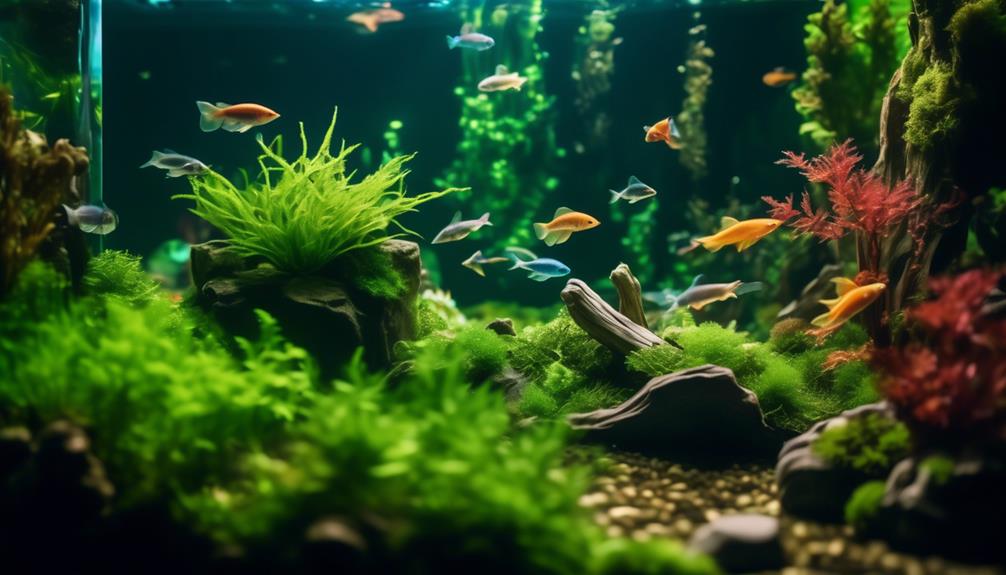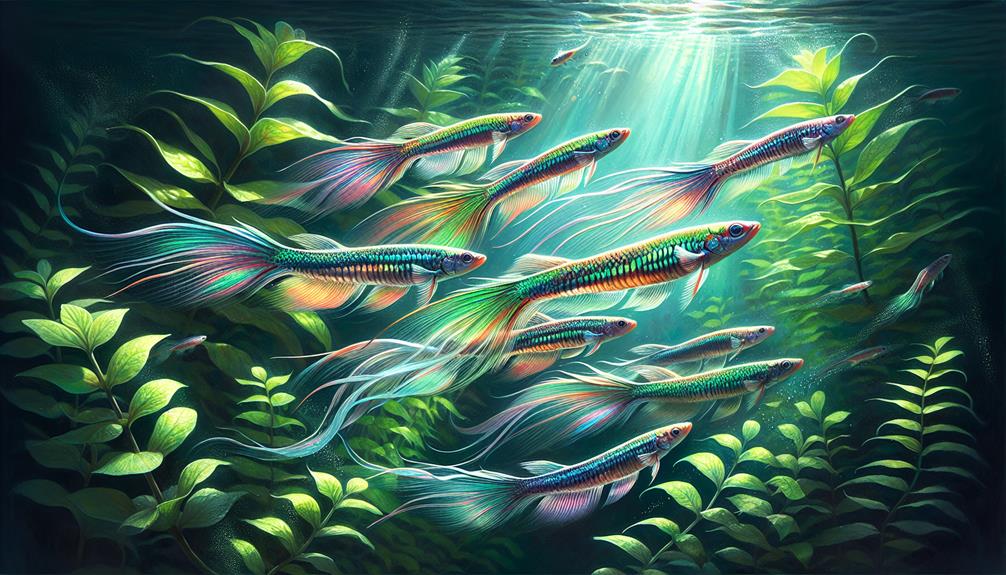Welcome to the captivating world of Endler's Livebearers, the colorful marvels that have captured the attention of aquarium enthusiasts worldwide.
With their vibrant colors and striking patterns, these fish are a sight to behold. But there's more to Endler's Livebearers than just their appearance.
In this article, we will explore their fascinating history, delve into the distinctions between Endlers and guppies, discuss the optimal habitat setup, delve into their dietary preferences, and even uncover the secrets of successful breeding.
So prepare to be amazed as we embark on this journey into the world of Endler's Livebearers, where beauty meets science.
Key Takeaways
- Endlers Livebearers, scientifically known as Poecilia wingei, are vibrant and colorful fish that can grow up to 1 inch (2.5 cm) in length for males and 1.8 inches (4.5 cm) for females.
- Endlers and guppies are closely related but different species, with Endlers being hardier and requiring less line breeding than guppies.
- Setting up an aquarium for Endlers is relatively easy as they can tolerate a wide range of water parameters and do not require a heater.
- When feeding Endlers Livebearers, a varied diet including flakes, pellets, Repashy gel food, and daphnia should be provided to enhance their immune system and coloration.
Endler's Livebearers: A Brief History
The history of Endler's Livebearers can be traced back to the rediscovery of Poecilia wingei by Dr. John Endler in Venezuela. Dr. Endler, a renowned scientist and conservationist, stumbled upon this species in the late 1970s during his fieldwork. Recognizing its unique characteristics, he collected some specimens and brought them back to the United States for further study.
Dr. Endler's efforts in documenting and studying these fish played a crucial role in their conservation and popularization in the aquarium hobby. However, the impact of hybridization with closely related species, such as guppies, has raised concerns regarding the preservation of pure Endler's Livebearers. Conservation efforts have been initiated to protect the genetic integrity of this species and prevent further hybridization.
Understanding the Differences: Endlers Vs. Guppies
Endlers and guppies, although closely related, exhibit distinct differences in their genetic makeup and physical characteristics. Endlers livebearers are Poecilia wingei, while guppies are Poecilia reticulata. However, when the two species interbreed, an Endler guppy is produced, combining the best traits of both worlds.
In terms of genetic makeup, Endlers require less line breeding and are generally hardier than guppies. This makes them a better choice for beginners or those looking for low-maintenance fish.
Physically, Endlers males are smaller, growing up to 1 inch (2.5 cm) in length, while guppies can reach lengths of 2-3 inches (5-7.5 cm). Endlers males have more vibrant colors and patterns, while guppies tend to have a wider range of color variations.
Ultimately, the choice between Endlers and guppies depends on personal preference. Endlers are recommended for those seeking hardier, low-maintenance fish with vibrant colors, while guppies offer a wider range of color options and larger size potential.
Setting Up the Perfect Habitat for Endlers

Understanding the distinct differences between Endlers and guppies lays the foundation for creating the optimal habitat for Endlers livebearers in aquariums. When setting up an aquarium for Endlers, it is important to consider their compatibility with other tank mates and the maintenance of water quality.
Choosing the right tank mates for Endlers is crucial to ensure their well-being. They are peaceful fish and should be housed with species that share similar temperament and water requirements. Good tank mates for Endlers include small peaceful fish like tetras, rasboras, and small catfish. It is important to avoid aggressive or fin-nipping species that may harm the Endlers.
Maintaining water quality is vital for the health of Endlers. Regular water changes of 20-30% should be performed every week to remove accumulated waste and maintain water parameters. The use of a reliable filtration system is recommended to keep the water clean and stable. Testing the water regularly for parameters such as pH, ammonia, nitrite, and nitrate levels is essential to ensure optimal conditions for the Endlers.
Incorporating a 2 column and 4 row table to summarize the information:
| Tank Mates for Endlers | Water Quality Maintenance |
|---|---|
| Tetras | Regular water changes |
| Rasboras | Reliable filtration system |
| Small Catfish | Testing water parameters |
| Peaceful Fish |
Feeding Your Colorful Aquarium Marvels
When it comes to nourishing your vibrant Endlers livebearers in the aquarium, providing a balanced and varied diet is essential for their overall health and stunning coloration. Endler's livebearers are not picky eaters and will consume various foods, including flakes, pellets, Repashy gel food, and daphnia.
They have scavenging feeding habits, constantly searching for food throughout the aquarium. To meet their nutritional requirements, it is important to offer a variety of foods to ensure they receive proper nutrition. Feeding them a balanced diet enhances their immune system and promotes vibrant coloration.
Regular feeding intervals should be followed, ensuring they receive an adequate amount of food without causing overeating or waste. By providing a diverse and nutritious diet, you can support the health and beauty of your Endlers livebearers in the aquarium.
Breeding Endler's Livebearers: Tips and Tricks

To successfully breed Endler's livebearers, there are several key tips and tricks that can optimize the breeding process and increase the survival rate of the fry. Here are four techniques to consider:
- Select healthy and genetically diverse breeding stock: Choose males and females with vibrant colors and patterns. Avoid inbreeding to maintain genetic diversity and vigor in the fry.
- Provide hiding places and dense vegetation: Adding floating plants, moss, and caves in the aquarium creates hiding spots for the fry, increasing their chances of survival. Dense vegetation also helps in reducing stress and providing a sense of security.
- Maintain water quality: Regular water changes and proper filtration are essential for optimal breeding conditions. Keeping the water clean and stable helps prevent diseases and stress, ensuring a higher survival rate for the fry.
- Separate fry from adults: As soon as the fry are born, it is important to separate them from the adults to prevent cannibalism. Use a breeding box, nursery tank, or mesh net to keep the fry safe until they are large enough to join the main tank.
Frequently Asked Questions
How Long Do Endlers Live?
The lifespan of endlers is influenced by factors such as genetics, water quality, and diet. With proper care, endlers can live for 2-3 years on average. They are considered beginner-friendly aquarium fish due to their hardiness and adaptability.
Can Endlers Live With Other Fish Species?
Are you wondering if Endlers can live with other fish species? Endlers are generally compatible with peaceful community fish, but avoid aggressive or fin-nipping species. Introduce them slowly and monitor behavior to ensure a harmonious tank environment.
What Is the Average Lifespan of Endler Fry?
The average lifespan of Endler fry depends on the optimal tank conditions and care provided. With proper nutrition and water parameters, the fry can have an average growth rate of 0.5-1 inch in a few months.
Can Endlers Change Their Colors Over Time?
Endlers' color variations can change over time due to factors such as genetics, diet, and environmental conditions. These factors can influence the intensity and pattern of colors, resulting in a dynamic and ever-changing display of vibrant hues in Endler's Livebearers.
Are Endlers Susceptible to Any Specific Diseases or Health Issues?
Endlers livebearers are generally hardy and less prone to diseases compared to guppies. However, both species can be susceptible to common aquarium ailments such as fin rot, ich, and swim bladder issues. Proper tank maintenance, regular water testing, and a balanced diet are essential for keeping Endlers healthy.
Conclusion
In conclusion, Endler's Livebearers are a captivating species for aquarium enthusiasts. With their vibrant colors, hardy nature, and ability to tolerate a wide range of water parameters, these fish make a stunning addition to any aquarium.
Their distinct differences from guppies and potential for hybridization add to their appeal. By providing a well-balanced diet and creating the ideal habitat for breeding, enthusiasts can enjoy the marvel of watching these beautiful fish thrive and reproduce.
Despite concerns about potential hybridization, the unique characteristics and beauty of Endler's Livebearers make them a true marvel in the world of aquarium fish.

